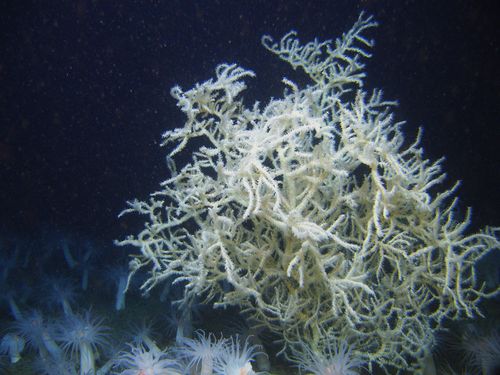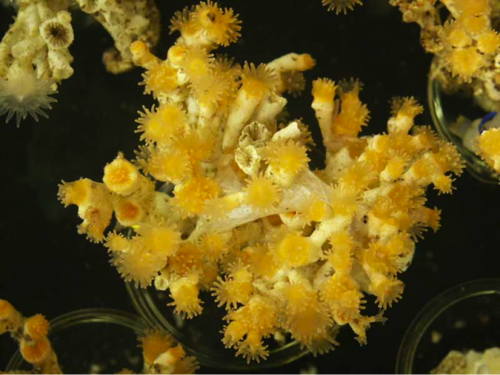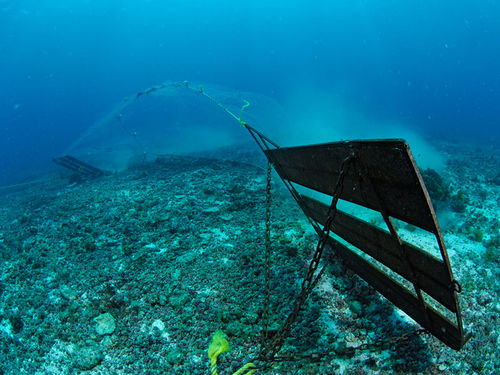Deepwater
Deepwater Coral
Not all coral species live in tropical, shallow waters. There are many species of coral which exist and thrive far below the ocean's surface. Deep-water corals (DWC), like tropical corals, can be very large, three dimensional skeletal frameworks that host a variety of organisms. However, unlike tropical reefs, cold corals do not depend on light to survive and instead rely on extended polyps for food. Less is known about cold corals than tropical corals, and new cold-water corals are being discovered as more of the ocean is explored [1].
Other terms: --“Mesophotic reefs”= DWC reefs, reefs without light, 30–150 m below sea level
---Mesophotic Coral Ecosystems--“MECs” [2]
Habitat
- Deepwater corals grow in all the world’s ocean basins, including the waters of the United Kingdom, Australia, New Zealand, Canada, Ecuador, Japan, Norway, and the United States.[1] They can be found in waters as deep as 6,000m and as cold as -1ºC. [1] However, temperature is an influencing factor of coral distribution, and they are most commonly found in waters ranging from 4 to 12 C. [3] For this reason, DWC are also commonly referred to as cold water coral (CWC). Other factors influencing coral distribution include salinity and competitive interactions with other organisms like sponges and algae. [4]
- Cold corals, as they are also called, often are found on seamounts, ocean canyons, and continental shelves and slopes. [4] Corals require a hard surface on which to attach, which could be exposed rock, substrate, or even dead coral. They generally colonize areas where strong currents are found, as corals rely on the steady flow of water to supply them with food, disperse larvae, and to remove wastes and sediments.[4] For this reason, corals are often found specifically on seamounts due to the strong currents.
Diet
Beyond 100 m of ocean, not enough light filters through for photosynthesis to occur. [5] Due to the lack of sunlight in their environment, deep-water corals do not depend on symbiotic relationships with zooxanthallae as their shallow water counterparts do. Deep-water corals are completely heterotrophic out of necessity. Rather than relying primarily on photosynthesizing zooxanthallae for energy, DWC must filer feed through the use of extended polyps which capture food particles and microorganisms as they float by. Consequently, DWC rely heavily on ocean currents to bring them their food source and can be greatly impacted by shifts in currents [5]. However, recent research has indicated that there may be a link between chemosynthesizing bacteria and mircoorganisms of the deep sea and DWC. A 2008 study by Jensen S. et al. has uncovered the possibility of symbiotic relationships between deep-water coral and methanotropes, which are microorganisms that obtain energy from underwater methane seeps.[6]
Life Cycle
Due to the difficulties inherent in observation of deep-water coral, little is known about their life cycle. Structural similarities between deep and shallow water corals have led scientists to believe that DWC likely undergo a life cycle similar to tropical corals.
-i.e. drifting medusa, attached coral polyp, mature coral structure, rubble---> mention the after-life phase? coral rubble- include link to "Threats to Coral", natural threats- bioerosion- boring of sponges.
-post link to Rachel's reproduction page for life cycle--- how do we link two Wiki pages together?
Species
Leiopathes glaberrima
Black corals are the oldest known marine organisms.[7] They live in excess of 4,000 years. Black corals have dark skeletons and irregularly branching, tree-like structures. The coral polyps attach to the base of the skeleton, and their mouths are located at the other end, ringed in tentacles to catch food. .[7] Unlike tropical coral reefs, cold corals do not contain zooxanthellae within their tissues, so they must catch their food on passing currents. They are found in both the Pacific and Atlantic, though their complete distribution is unclear. .[7] Deep-water Black Coral is threatened by habitat degradation and also the trade of live corals for aquariums. .[7] While the trade is small, it is not sustainable as slow growing as black coral.

Lophelia pertusa
Lophelia pertusa are stony, deep-water corals mainly occurring mainly on the continental shelf and are one of the few species able to build a coral framework in the deep ocean.[3] They are rarely attached to soil substrata, but occur on soft ocean bottoms greater than 150m and even occasionally on oil industry structures where currents are strong.[8] The skeletons of Lophelia pertusa polyps occur in bush-like colonies that may join together to form a larger reef, joined together by their external calcareous skeletons. .[8] Individual polyps are white, pink, or yellowish, and contain up to 50 tentacles. Within the reef, stony corals are protected against other animals growing in the reef by a layer of mucus.[9] Even so, stony corals are a biodiversity hotspot and provide habitat to a variety of species at the edge of the continental shelf. They are threatened by bottom trawling and oil extraction. .[8] It is also though that deep, cold-water, stony corals are among the first marine organisms to be affect by ocean acidification. .[3]

Madrepora oculata
Along with L. pertusa, it is one of the two main base corals of the Atlantic Ocean. Can be found at depths of 200-1,000m. [6]
Importance
Just as with tropical coral reefs, deep water corals are important for a number of reasons, mainly due to their integral role in the functioning of other systems. They provide critical ecological services that have value both to marine species and to humans. Deepwater coral reefs provide critical habitat to a disproportionate number of marine species. There is high species diversity around cold corals as well as high endemism.[4] Cold corals are essential as nurseries to juvenile fish and the framework of corals create sub-habitats for a variety of marine organisms.[4] Cold water corals provide habitats for both micro and macrofauna-- more on these relations in this source [6]
- "connectivity of mesophotic reefs to shallow reefs and the importance of MCEs to the persistence of tropical reef biodiversity" [2]
Value to Humans
- Cold corals are commercially important in that they provide deep-sea habitats to many commercial fish species. Off the Aleutian Islands, 85% of commercial fisheries are associated with cold corals.[1]
- Corals are also an important resource for new medicines.The chemicals that corals produce have potential to be used in fields such as oncology to create novel medicines such as anti-tumor compounds. [1]
- Coral are also used in jewelry, and can support local and commercial industries, though this aspect of coral use is not always sustainable, and can also be a direct, physical threat to the coral. [10]
Significance to Climatology
- Another source of coral importance is the use of coral in paleoclimatology. Since deep water corals are so long lived, they provide important clues about past ocean temperatures and chemistry.[10]
Threats
Natural
As in any ecosystem, deep-water coral experiences negative effects from other members of the benthic plant and animal communities. The major natural factor which negaticely impact DWC growth is bioerosion.
Bioerosion
- DWC experiences bioerosion much like shallow reefs do. However, in both areas, the main contributors are different:
- parrotfish in shallow coral -- grazing
- sponges in DWC- boring --- post pics from study that look like swiss cheese [2]
- --In general, grazing decreases with increasing depth, but boring of sponges does not- may actually intensify since there are more sponges in the benthic zones of DWC reefs
Anthropogenic
Many of the most devastating threats facing deep-water coral reefs are posed by humans. These threats stem from particular practices such as unsustainable fishing methods and also from lifestyle choices which affect the planet as a whole.
Bottom Trawling
- One of the greatest threats to deep-water coral is the affect of bottom trawling. Bottom trawling has been shown to smooth out the sea floor and destroy habitat for corals.[1] Bottom trawling directly affects reefs by catching coral in fishing nets and removing the coral framework. It also destroys the coral itself by shattering the fragile and easily broken skeletons. If enough coral is removed or damaged, the reef can reach a size where it is not longer sexually viable and does not have enough members to reproduce. Recruitment of larvae becomes sporadic. This is particularly significant because cold corals are slow growing and take thousands of years to fully develop.[4]
- Bottom trawling has increased in recent years due to the overfishing of shallow waters. However, bottom trawling can be counterproductive in that by destroying deep-water reefs, fishermen also destroy critical habitat for many commercial fish species. The new technology used in these deep-water fisheries has shown an increased, negative affect on coral species, characterized by heavy coral by-catch. However, as coral reefs have been removed, the incidence of bycatch has decreased.[4]
Climate Change
While global temperature fluctuation might not be as big a problem to these stoic survivors of the deep, side effects of temperature changes are an issue.
-brief discussion of how climate change affects ocean currents
Since they are a stationary species, many deep-water corals depend heavily on ocean currents to bring them food particles on which to filter feed. Furthermore, they are impacted by shifts in ocean currents even more so than shallow reef species because they do not have the option of living on energy from photosynthesis of zooanthalae. What the currents bring these corals is all that they will have access to.
Also, climate change has further-reaching impacts on ocean water itself.
Ocean Acidification
-briefly explain ocean acidification---link to more in-depth wiki page? -rising levels of CO2, higher levels of carbon in ocean, can cause stunted growth and more fragile skeletons
--While shallow water corals share the same water and are also damaged by ocean acidification, This problem is significantly worse for deep-water corals because they grow more slowly, so any inhibition at all to normal growth patterns could be extremely harmful or detrimental. ---Harder for DWC to recover.
Other threats include
- Oil and gas exploration, especially in the event of oil spills
- Jewelry or curios made from cold corals [1]

Conservation
However, legislative efforts have thus far been centered on conservation rather than restoration. In 2006, the General Fisheries Commission of the Mediterranean created the first legal gategory of "Deep-sea fisheries restricted areas" with the prohibition of dredging and trawling in the DWC banks of Santa Maria (source). Likewise, in 2013, Chile became the first country to protect all of its seamounts from bottom trawling (source). However, current legal measures do not offer protection to coral rubble- what is left in the aftermath of most trawling zones. Recent research by Bongiorni et al suggests that coral rubble, which is generally regarded as a lost cause, can actually still sustain life and even increase species diversity by offering a habitat to higher order consumers. (source)
-MPAs
-Areas of restricted fishing equipment-- i.e. no trawling zones
-Legislation- include case study of successful conservation of Darwinian Mounds
Challenges with Conservation
One of the largest problems with DWC conservation efforts is lack of research. This is mainly due to the inherent difficulty of studying these corals at such great depths. During the past 15 years, scientists have made use if new technologies such as Remotely Operated Vehicles (ROVs) and Autonomous Underwater Vehicles (AUVs) to carry out deep sea research and mapping. Though advancements in these technologies have allowed for more deep sea research, the open ocean floor is an area still vastly unexplored. With this unvisited territory lies the possibility of undiscovered DWC reefs. [1] [11]
Due to this lack of data, scientists are left the task of predicting the quantity of DWC in the world. Without a more exact count of existing reefs, scientists cannot know the extent of damage that human activities such as trawling are causing globally. They can only compare damaged reefs against their former selves or nearby reefs, making it difficult to prove the global impacts and urgency of DWC degradation or to recommend specific courses of action. For these reasons, legislation has so far only been targeted at specific localized sites where the damage can be clearly quantified and recored. [11] This means that only responsive legislation is being instituted. In order to put proactive and preventative legal measures in place, scientists need much more data on the location, distribution, and current states of DWC reefs.
Another challenge to legislation and conservation is that many of the DWC reefs that are known exist in international waters, on deep-water seamounts and along tectonic plate boundaries and methane seeps. [6] In these areas, only international legislation would be effective, since laws of one country would be ignored and exploited by unregulated competitors (mainly in the commercial fishing industry). However, because it requires agreement from all countries regarding a shared resource, this type of legislation is the most difficult to enact.
Further Links
Deepwater corals are comparable to trees
References
- ↑ 1.0 1.1 1.2 1.3 1.4 1.5 1.6 1.7 Deep-sea Corals. (n.d.). Retrieved February 20, 2015, from http://ocean.si.edu/deep-sea-corals Cite error: Invalid
<ref>tag; name "smithsonian" defined multiple times with different content Cite error: Invalid<ref>tag; name "smithsonian" defined multiple times with different content Cite error: Invalid<ref>tag; name "smithsonian" defined multiple times with different content Cite error: Invalid<ref>tag; name "smithsonian" defined multiple times with different content Cite error: Invalid<ref>tag; name "smithsonian" defined multiple times with different content - ↑ 2.0 2.1 2.2 Weinstein DK, Smith TB, Klaus JS. Mesophotic bioerosion; variability and structural impact on U. S. Virgin Island deep reefs. Geomorphology 2014 Oct 01;222:14-24. Retrieved from: http://dx.doi.org/10.1016/j.geomorph.2014.03.005
- ↑ 3.0 3.1 3.2 Maier, C., J. Hegeman, M. G. Weinbauer, and J. P. Gattuso. "Calcification of the Cold-water Coral Lophelia Pertusa under Ambient and Reduced PH." Biogeosciences (2009): 1671-680. Print.
- ↑ 4.0 4.1 4.2 4.3 4.4 4.5 4.6 Rodgers, Alex. "The Biology, Ecology and Vulnerability of Deep-Water Coral Reefs." IUCN. British Antarctic Survey, 1 Jan. 2004. Web. 10 Feb. 2015.
- ↑ 5.0 5.1 http://www.waterencyclopedia.com/La-Mi/Light-Transmission-in-the-Ocean.html Cite error: Invalid
<ref>tag; name "waterencyclopedia" defined multiple times with different content - ↑ 6.0 6.1 6.2 6.3 1. Jensen S, Neufeld JD, Birkeland N, Hovland M, Murrell JC. Insight into the microbial community structure of a Norwegian deep-water coral reef environment. Deep Sea Research (Part I, Oceanographic Research Papers) 2008 11;55(11):1554-63. Retrieved from: http://dx.doi.org/10.1016/j.dsr.2008.06.008 Cite error: Invalid
<ref>tag; name "jensen" defined multiple times with different content Cite error: Invalid<ref>tag; name "jensen" defined multiple times with different content - ↑ 7.0 7.1 7.2 7.3 "Black Coral (Leiopathes Glaberrima)." Wildscreen Arkive. Web. 20 Feb. 2015. http://www.arkive.org/black-coral/leiopathes-glaberrima/.
- ↑ 8.0 8.1 8.2 Frances Peckett 2003. Lophelia pertusa. A cold water coral. Marine Life Information Network: Biology and Sensitivity Key Information Sub-programme [on-line]. Plymouth: Marine Biological Association of the United Kingdom. http://www.marlin.ac.uk/speciesinformation.php?speciesID=3724
- ↑ "Basics." Lophelia.org. Web. 20 Feb. 2015. <http://www.lophelia.org/>.
- ↑ 10.0 10.1 "Why Are Deep-sea Corals Important?" NOAA's Coral Reef Conservation Program. NOAA, 1 Aug. 2011. Web. 10 Feb. 2015. http://coralreef.noaa.gov/deepseacorals/about/facts/dsc_important.html
- ↑ 11.0 11.1 RB, Huvenne VAI, Le Bas T,P., Murton BJ, Connelly DP, Bett BJ, Ruhl HA, Morris KJ, Peakall J, Parsons DR, et al. Autonomous underwater vehicles (AUVs); their past, present and future contributions to the advancement of marine geoscience. Mar Geol 2014 Jun 01;352:451-68. Retrieved from: http://dx.doi.org/10.1016/j.margeo.2014.03.012